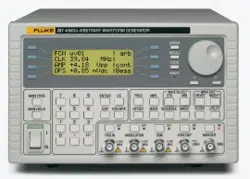Loading ...
Loading ...
Loading ...

291, 292, 294
Users Manual
Note
On multi-channel instruments the channel to be edited must first be selected
by pressing the appropriate SETUP key; the lamp lights beside the
SETUP key of the channel currently enabled for editing.
A diamond beside a screen item indicates that it is selectable; hollow diamonds (
)
identify deselected items and filled diamonds (
) denote selected items. For example,
press MODE to get the screen shown below:
MODE:
continuous
gated setup…
triggered setup…
The filled diamond indicates that the selected mode is continuous. Gated or
triggered modes are selected by pressing the associated soft-key which will make
the diamond beside that item filled and the diamond beside continuous hollow.
This screen also illustrates how an ellipsis (three dots following the screen text) indicates
that a further screen follows when that item is selected. In the case of the MODE screen
illustrated, pressing the setup… soft-key on the bottom line brings up the
TRIGGER SETUP menu; note that selecting this item does not change the selection of
continuous, gated or triggered.
Some screen items are marked with a double-headed arrow (
) when selected to indicate
that the item’s setting can be changed by further presses of the soft-key, by pressing
either cursor key or by using the rotary control. For example, pressing FILTER brings
up the screen shown below.
FILTER
mode: auto
type: 40MHz eliptic
Repeated presses of the mode soft-key will toggle the mode between its two possible
settings of auto and manual. Similarly, when type is selected, repeated presses
of the type soft-key (or cursor keys or use of the rotary control) will step the selection
through all possible settings of the filter type.
In addition to their use in editing items identified by a double-headed arrow as described
above, the cursor keys and the rotary control operate in two other modes.
In screens with lists of items that can be selected (i.e. items marked with a diamond) the
cursor keys and rotary control are used to scroll all items through the display if the list
has more than three items; look, for example at the STD (standard waveform) and
UTILITY screens.
In screens where a parameter with a numeric value is displayed the cursor keys move the
edit cursor (a flashing underline) through the numeric field and the rotary control will
increment or decrement the value; the step size is determined by the position of the edit
cursor within the numeric field.
4-4
1.888.610.7664 sales@GlobalTestSupply.com
Fluke-Direct.com
Loading ...
Loading ...
Loading ...
